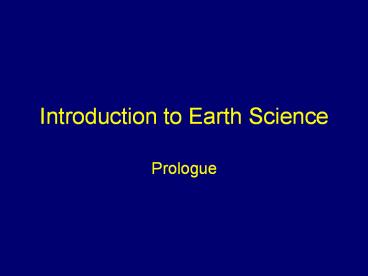Introduction to Earth Science - PowerPoint PPT Presentation
1 / 66
Title:
Introduction to Earth Science
Description:
Introduction to Earth Science Prologue INTRODUCTION TO EARTH SCIENCE Earth science- -study of Earth s systems Includes: Includes: -meteorology Includes ... – PowerPoint PPT presentation
Number of Views:403
Avg rating:3.0/5.0
Title: Introduction to Earth Science
1
Introduction to Earth Science
- Prologue
2
- INTRODUCTION TO EARTH SCIENCE
- Earth science-
- -study of Earths systems
- Includes
3
(No Transcript)
4
(No Transcript)
5
- Includes
- -meteorology
6
(No Transcript)
7
- Includes
- -meteorology
- -astronomy
8
(No Transcript)
9
(No Transcript)
10
(No Transcript)
11
- Includes
- -meteorology
- -astronomy
- -geology
12
(No Transcript)
13
- Includes
- 1) meteorology
- 2) astronomy
- 3) geology
- 4) oceanography
14
- OBSERVATION-
- -Use senses for information
- -We use INSTRUMENTS to extend the senses
15
(No Transcript)
16
(No Transcript)
17
(No Transcript)
18
- OBSERVATION-
- -Use senses for information
- -We use INSTRUMENTS to extend the senses
- INFERENCE-
- -make a conclusion (guess)
- -making sense of observations
19
(No Transcript)
20
(No Transcript)
21
(No Transcript)
22
(No Transcript)
23
- CLASSIFICATION-
- -arranging into groups
- -helps organize information
24
- Scientific notation-
- shorthand for numbers
- Example
- 3.0 x 103
- 3.0 x (10x10x10) 3000
25
- Do now
- 3.5 x 103 ______________
- 8.6 x 105 _______________
- 7.4 x 102 _______________
26
- 80,000 8 x 104
- 520,000,000
- 42,000,000,000,000
27
(No Transcript)
28
- PERCENT ERROR-
- -how wrong you are
29
Accepted value correct answer Measured value
your guess
?
- Temperature?
Accepted value -
measured value PCT ERROR --------------------
-------------------------- x 100
accepted value
30
?
- Temperature?
Accepted value -
measured value PCT ERROR --------------------
-------------------------- x 100
accepted value
31
There are 495 jellybeans.
Accepted value -
measured value PCT ERROR --------------------
-------------------------- x 100
accepted value
32
- Practice
- A student measures a table to be 1.9m long. In
reality it is 2.0m long. What is the percent
error of the student? - 2.0 1.9 X 100 5
- 2.0
33
- A student measures a room to be 6.9m. If
the actual length is 7.5m, the students percent
error is? - 7.5 6.9 X 100 8
- 7.5
34
- A student determines the volume of a cube to
be 8.6cm3. The correct volume is really 8.0cm3.
What is the students percent error? - 8.6 8.0 X 100 7.5
- 8.0
35
- Graphs -
- A visual way to present data
- Types of graphs
- -line graphs
36
- Types of graphs
- -line graphs
- Uses coordinates (x and y axis)
37
- Types of graphs
- -line graphs
- direct indirect or inverse cyclic
- relationship relationship
relationship
38
- Rules for making graphs
- 1) The graph should be as simple and easy to
read as possible.
39
- Rules for making graphs
- On each axis, equal intervals must represent
equal changes
40
- Rules for making graphs
- 3) Time is always plotted on the x
(horizontal) axis
41
- Rules for making graphs
- 4) When possible, make best fit line(s)
42
- Rules for making graphs
- 5) Fit the graph to the paper. Make it large
enough to fit most of the paper.
43
- Rules for making graphs
- 6) Label each axis with quantity and units
44
- Rules for making graphs
- 7) The graph should make sense.
45
Can you find the error in this graph?
Should be a line graph
46
Line should not start at zero Neither axis is
labeled with units
47
Labels on axis switched
48
Graph does not fit line Vertical axis does not
increase evenly
49
- DENSITY
50
- Density-
- -how heavy an object is compared to an
object of the same size - mass
- Density ------------------
- volume
- units for mass g
- units for volume cm3 or ml
- units for density g/cm3 or g/ml
51
- example
- volume of cube 40cm3
- mass of cube 70g
- density ?
52
- but..
53
- ButWhat if you cut the cube in half?
- Do now
- volume 40cm3 20cm3
- mass 70g 35g
- density _______________
- the density of an object doesnt change
54
- Example 2
- volume of rectangle _____ mass of rectangle
100g - density ?
4 cm
2 cm
3 cm
Volume length x width x height
55
Which is more dense?
56
Which is more dense?
57
Which is more dense?
58
Which is more dense?
59
Which is more dense?
60
- Average densities
- -water 1 g/cm3 at 4o C
- below 4oC the density of water decreases.
Above 4oC, the density of water increases - -Ice 0.5 g/cm3
- -Earth 5.5 g/cm3
- -Saturn 0.7 g/cm3
- -human ?
61
- rate of change-
- -How fast something changes
- change in value
- rate of change ----------------------
- change in time
62
- example
- From 300 pm to 600 pm the air temperature
falls from 85oF to 79oF. What is the rate of
change for temperature during this time? - Rate of change
63
- Do now
- In 60 years, the shoreline at Rye Beach has
shrunk by 30 inches. What is the rate of change
for the shoreline?
64
(No Transcript)
65
(No Transcript)
66
- Some changes are cyclic.
- Examples































